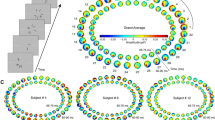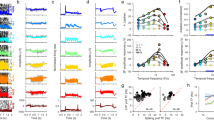Abstract
Nonlinear analysis of the multifocal cortical visual evoked potential has allowed the identification of neural generation of higher-order nonlinear components by magnocellular and parvocellular neural streams. However, the location of individual brain sources that make such contributions to these evoked responses has not been studied. Thus, an m-sequence pseudorandom stimulus system was developed for use in magnetoencephalographic (MEG) studies. Five normal young adults were recorded using an Elekta TRIUX MEG with 306 sensors. Visual stimuli comprised a nine-patch dartboard stimulus, and each patch fluctuated between two luminance levels with separate recordings carried out at low (24 %) and high (96 %) temporal contrast. Sensor-space analysis of MEG evoked fields identified components of the first- and second-order Wiener kernel decomposition that showed qualitative similarity with EEG-based cortical VEP recordings. The first slice of the second-order response (K2.1) was already saturated at 24 % contrast, while the major waveform of the second slice of the second-order response (K2.2) grew strongly with contrast, consistent with properties of the magnocellular and parvocellular neurons. Minimum norm estimates of cortical source localization showed almost simultaneous activation of V1 and MT+ activations with latencies only a little greater that those reported for first neural spikes in primate single cell studies. Time–frequency analysis of the kernel responses from five minimum norm estimate scout sources shows contributions from higher-frequency bands for the first compared with the second slice response, consistent with the proposed neural sources. In support of this magno/parvo break-up, the onset latencies of the K2.2 responses were delayed by approximately 30 ms compared with K2.1 responses.





Similar content being viewed by others
References
Baseler HA, Sutter EE, Klein SA, Carney T (1994) The topography of visual evoked response properties across the visual field. Electroencephalogr Clin Neurophysiol 90:65–81
Berman RA, Wurtz RH (2010) Functional identification of a pulvinar path from superior colliculus to cortical area MT. J Neurosci 30:6342–6354. doi:10.1523/JNEUROSCI.6176-09.2010
Bullier J (2001) Integrated model of visual processing. Brain Res Brain Res Rev 36:96–107
Butler PD et al (2007) Subcortical visual dysfunction in schizophrenia drives secondary cortical impairments. Brain 130:417–430. doi:10.1093/brain/awl233
Engel SA, Rumelhart DE, Wandell BA, Lee AT, Glover GH, Chichilnisky EJ, Shadlen MN (1994) fMRI of human visual cortex. Nature 369:525. doi:10.1038/369525a0
Henriksson L, Karvonen J, Salminen-Vaparanta N, Railo H, Vanni S (2012) Retinotopic maps, spatial tuning, and locations of human visual areas in surface coordinates characterized with multifocal and blocked FMRI designs. PLoS One 7:e36859. doi:10.1371/journal.pone.0036859
Hood DC, Greenstein VC (2003) Multifocal VEP and ganglion cell damage: applications and limitations for the study of glaucoma. Prog Retin Eye Res 22:201–251
Hupe JM, James AC, Payne BR, Lomber SG, Girard P, Bullier J (1998) Cortical feedback improves discrimination between figure and background by V1, V2 and V3 neurons. Nature 394:784–787. doi:10.1038/29537
Hupe JM, James AC, Girard P, Lomber SG, Payne BR, Bullier J (2001) Feedback connections act on the early part of the responses in monkey visual cortex. J Neurophysiol 85:134–145
Jackson BL et al (2013) Magno- and parvocellular contrast responses in varying degrees of autistic trait. PLoS ONE 8:e66797. doi:10.1371/journal.pone.0066797
Kaplan E, Shapley RM (1986) The primate retina contains two types of ganglion cells, with high and low contrast sensitivity. Proc Natl Acad Sci USA 83:2755–2757
Klistorner A, Crewther DP, Crewther SG (1997) Separate magnocellular and parvocellular contributions from temporal analysis of the multifocal VEP. Vis Res 37:2161–2169
Lalor EC, Foxe JJ (2009) Visual evoked spread spectrum analysis (VESPA) responses to stimuli biased towards magnocellular and parvocellular pathways. Vis Res 49:127–133. doi:10.1016/j.visres.2008.09.032
Lalor EC, Pearlmutter BA, Reilly RB, McDarby G, Foxe JJ (2006) The VESPA: a method for the rapid estimation of a visual evoked potential. Neuroimage 32:1549–1561. doi:10.1016/j.neuroimage.2006.05.054
Lamme VA, Roelfsema PR (2000) The distinct modes of vision offered by feedforward and recurrent processing. Trends Neurosci 23:571–579
Laycock R, Crewther SG, Crewther DP (2007) A role for the ‘magnocellular advantage’ in visual impairments in neurodevelopmental and psychiatric disorders. Neurosci Biobehav Rev 31:363–376. doi:10.1016/j.neubiorev.2006.10.003
Laycock R, Crewther DP, Crewther SG (2008) The advantage in being magnocellular: a few more remarks on attention and the magnocellular system. Neurosci Biobehav Rev 32:1409–1415. doi:10.1016/j.neubiorev.2008.04.008
Maunsell JH, Ghose GM, Assad JA, McAdams CJ, Boudreau CE, Noerager BD (1999) Visual response latencies of magnocellular and parvocellular LGN neurons in macaque monkeys. Vis Neurosci 16:1–14
Nassi JJ, Callaway EM (2009) Parallel processing strategies of the primate visual system. Nat Rev Neurosci 10:360–372
Nishiyama T, Ohde H, Haruta Y, Mashima Y, Oguchi Y (2004) Multifocal magnetoencephalogram applied to objective visual field analysis. Jpn J Ophthalmol 48:115–122. doi:10.1007/s10384-003-0044-9
Sehatpour P, Dias EC, Butler PD, Revheim N, Guilfoyle DN, Foxe JJ, Javitt DC (2010) Impaired visual object processing across an occipital-frontal-hippocampal brain network in schizophrenia: an integrated neuroimaging study. Arch Gen Psychiatry 67:772–782. doi:10.1001/archgenpsychiatry.2010.85
Sereno MI et al (1995) Borders of multiple visual areas in humans revealed by functional magnetic resonance imaging. Science 268:889–893
Super H, Lamme VA (2007a) Altered figure-ground perception in monkeys with an extra-striate lesion. Neuropsychologia 45:3329–3334. doi:10.1016/j.neuropsychologia.2007.07.001
Super H, Lamme VA (2007b) Strength of figure-ground activity in monkey primary visual cortex predicts saccadic reaction time in a delayed detection task. Cereb Cortex 17:1468–1475. doi:10.1093/cercor/bhl058
Sutherland A, Crewther DP (2010) Magnocellular visual evoked potential delay with high autism spectrum quotient yields a neural mechanism for altered perception. Brain 133:2089–2097. doi:10.1093/brain/awq122
Sutter EE (1992) A deterministic approach to nonlinear systems analysis. In: Pinter RB, Nabet B (eds) Nonlinear vision. CRC Press, Cleveland, pp 171–220
Sutter E (2000) The interpretation of multifocal binary kernels. Doc Ophthalmol 100:49–75
Tabuchi H, Yokoyama T, Shimogawara M, Shiraki K, Nagasaka E, Miki T (2002) Study of the visual evoked magnetic field with the m-sequence technique. Investig Ophthalmol Vis Sci 43:2045–2054
Tadel F, Baillet S, Mosher JC, Pantazis D, Leahy RM (2011) Brainstorm: a user-friendly application for MEG/EEG analysis. Comput Intell Neurosci 2011:879716. doi:10.1155/2011/879716
Taulu S, Simola J (2006) Spatiotemporal signal space separation method for rejecting nearby interference in MEG measurements. Phys Med Biol 51:1759–1768. doi:10.1088/0031-9155/51/7/008
Vanni S, Henriksson L, James AC (2005) Multifocal fMRI mapping of visual cortical areas. NeuroImage 27:95–105. doi:10.1016/j.neuroimage.2005.01.046
Acknowledgments
The authors wish to acknowledge funding support of the National Health and Medical Research Council of Australia for project grant support (#1004740) and also the assistance of the staff of the Neuroimaging Facility at Swinburne University of Technology. The authors declare no competing financial interests.
Author information
Authors and Affiliations
Corresponding author
Rights and permissions
About this article
Cite this article
Crewther, D.P., Brown, A. & Hugrass, L. Temporal structure of human magnetic evoked fields. Exp Brain Res 234, 1987–1995 (2016). https://doi.org/10.1007/s00221-016-4601-0
Received:
Accepted:
Published:
Issue Date:
DOI: https://doi.org/10.1007/s00221-016-4601-0




